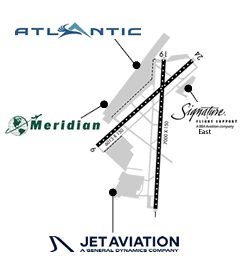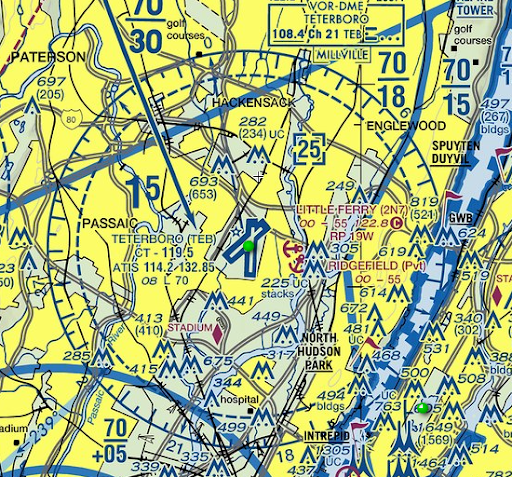¶ Standard Operating Procedure
This manual provides guidelines for the control of air traffic at Teterboro Airport. All air traffic personnel are required to be familiar with its contents. These procedures supplement the Air Traffic Control Handbook, Order 7110.65, and the Facility Operation and Administration Handbook, Order 7210.3.
- ICAO: KTEB
- Airspace: Class D (underneath Class B)
- TRACON: NY TRACON (EWR Area)
- Teterboro Airport is a towered Class Delta general aviation airport located near the northwestern part of the New York metropolitan area, in New Jersey. The Hackensack River is about a mile to the east, while the Passaic River is 2 NM west. Manhattan Island and the Hudson River are within 5 NM to the southeast. LaGuardia Airport is located 10 NM east-southeast, and Newark Liberty International Airport is 10 NM south-southwest.
- Teterboro is 12 NM from Midtown Manhattan, making it popular for private and corporate aircraft.
- New York Class B overlies and surrounds the Teterboro Class D.
- Teterboro is a High Density Traffic Airport
- Multiple uncontrolled helicopter and fixed wing traffic operating on the Hudson and East Rivers.
- Traffic to/from Newark and LaGuardia airports in the vicinity of the airport.
¶ Charts
¶ Contact
Daniel Mesko
New York ARTCC Chief (KZNY-CH)
kzny-ch@ivao.aero
¶ IFR
| SID | Type | Pronounciation | Transition | Runways | Top Altitude | Notes |
|---|---|---|---|---|---|---|
| TEB# | Vectors | Teterboro | - | All | 2000 | Default SID |
| DALTON# | Visual w/vectors | Dalton | 19 | 1300 | Visual departure (VFR with transition to IFR) when EWR is running 22s. Aircraft cross beneath the final approach course for EWR 22s. New York Departure will give climb clearance and vectors once west of the EWR 22s final approach course. Climb clearance constitutes IFR activation. | |
| RUUDY# | Hybrid | Rudy | - | 24 | 2000 | RNAV routing ends in vectors to exit gate |
Note: These top altitudes do not imply unrestricted climbs. Each SID has altitude restrictions at various points
All clearances use radar vectored departure phraseology (SID + “radar vectors” FIX)
IFR Clearance Example
Cleared to Pittsburgh via the Teterboro 3 departure, radar vectors to PARKE, then as filed. Climb via the SID, expect flight level three-two-zero one-zero minutes after departure. Departure frequency 122.8, squawk 3612.
¶ VFR
Departures:
- VFR aircraft will be given a “fly RWY heading” assignment and a Squawk Code before being instructed to contact ground for taxi.
- Teterboro is a Class Delta airport but is in close proximity to the New York Class Bravo; therefore, all VFR traffic must maintain 2-way radio communication.
- Special VFR departures:
- Skyline Route: must receive approval from Newark Tower for Class Bravo clearance.
- Hudson Exclusion Zone: Aircraft entering the Hudson Exclusion Zone enter at the George Washington Bridge.
Departure Altitudes:
- Jets: At or below 1,500
- Props: At or below 1,000
- Helicopters: At or below 500
Phraseology Example:
Westbound departure approved, fly runway heading, maintain VFR at or below 1500 until further advised. Departure Frequency XXX.XX, Squawk 0301
¶ Strip Marking
Make sure to fill the aircraft strip (scratchpad) with the SID and altitude assigned. In the case of climbs/transitions, the assigned climb/transition must be filled in.
¶ Squawk Code Assignments
All ATC are advised to use the REQ SSR tool in Aurora for squawk code assignments.
For reference, these are the typical ranges for Teterboro:
- VFR: 0301-0317
- ARTCC External IFR: 1301-1377
- ARTCC Internal IFR: 4201-4227
¶ Area of Responsibility
All movement areas and taxiways.
¶ Taxi Instructions
- GC must make sure that an aircraft has received IFR or VFR clearance before issuing taxi instructions.
- There are no preferred taxiway routes. As there are no parallel taxiways, all taxiways are considered two-way.
- If there are multiple departing traffic, GC should try to sequence them by alternating gate groups to minimize separation minima.
- In case an aircraft requests closed traffic (aerodrome traffic pattern), coordinate with TEB TWR, or whoever is assuming control of it, before issuing taxi instructions.
¶ Parking
- There are multiple FBOs operating at Teterboro.

¶ Airspace

¶ Runway Configuration
-
Always refer to the real ATIS when selecting active runways: https://datis.clowd.io/KTEB
-
Teterboro traffic flow always follows Newark’s flows. The following flows are used:
South Flow (EWR 22s)
- ARR 19
- DEP 24
Between 2200 and 0700 local time, departures on 19 (noise abatement)
North Flow (EWR4s)
- ARR 6
- DEP 1
In strong wind, both arrivals and departures can operate on runway 24.
There are never arrivals on runway 1.
¶ Go-around Procedures
| Runway | Heading | Altitude |
|---|---|---|
| 6 | Heading 300 | 2000 |
| 19 | Heading 270 | 1500 |
| 24 | Heading 260 | 1500 |
¶ VFR Closed Traffic Operations
| Runway | Pattern Direction |
|---|---|
| 1 | Left |
| 6 | Right |
| 19 | Left |
| 24 | Left |
¶ VFR Departures
- VFR departures must be kept at their initial altitude prior to the handoff with the respective N90 area controller.
- VFR practice approaches are subject to approval from N90 TRACON.
¶ Helicopter Operations
- TEB ATCT may assign helicopter routes as depicted in the FAA New York Helicopter Route chart.
- Altitudes assigned should be sufficient in order to avoid close encounter with buildings around the airport, while respecting the ceiling base. SVFR is not permitted inside the New York Class B airspace.
- Flights on a southbound or eastbound route must be thoroughly coordinated with N90 TRACON prior to departure.
¶ N90 Area Flights
All VFR/IFR flights to airports in the N90 area (LGA, EWR, TEB, CDW, MMU, FRG, ISP and HPN) must be thoroughly coordinated with N90 TRACON and the ATCT facilities covering the flight’s intended flightpath. N90 TRACON reserves the right to restrict releases for these operations.
¶ Area of Responsibility
Teterboro approach airspace is part of the N90 Newark Area (EWR).
¶ STARs
| STAR | Pronounciation | Notes | Bottom Altitude |
|---|---|---|---|
| JAIKE# | Jayk-ee | This is an RNAV arrival with vertical guidance. ZDC will clear aicraft to descend via the STAR. | 7000 over REGLE |
| MAZIE# | Mayz-ee | This is an RNAV arrival with vertical guidance. ZDC will clear aicraft to descend via the STAR. | 7000 over REGLE |
| LVZ# (Wilkes-Barre) | Wilks-Bear-ee | This is not an RNAV arrival. ZNY will issue descent to cross MUGZY at 6000 | 6000 over MUGZY |
All stars end in radar vectors to final approach from the appropriate N90 EWR air traffic controller.
¶ Instrument Approaches
North Ops
| Approach | Notes |
|---|---|
| ILS Z 06 | default |
| RNAV (GPS) X 06 | if EWR is using DEVIL# departure |
| RNAV (GPS) Y 06 | - |
| RNAV (RNP) Z 06 | authorization required |
South Ops
| Approach | Notes |
|---|---|
| ILS 19 | - |
| RNAV (GPS) X 19 | default nighttime (noise abatement) |
| RNAV (GPS) Y 19 | default daytime |
| RNAV (RNP) Z 19 | authorization required |
| RNAV (GPS) 24 | strong winds, when 24 is preferred arrival runway |